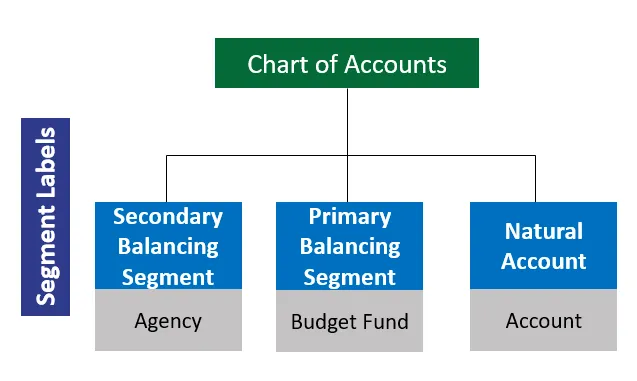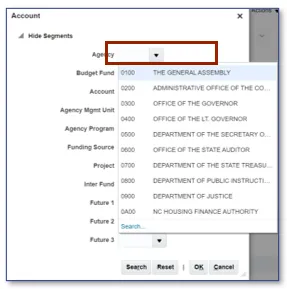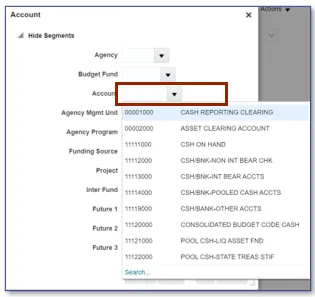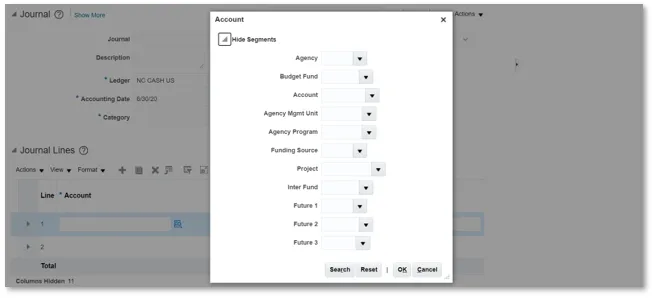Purpose
The purpose of this Quick Refence Guide (QRG) is to provide information on the New State Chart of Accounts in the North Carolina Financial System (NCFS).
Introduction and Overview
This QRG provides General Ledger (GL) users with conceptual information of the Release 1 NCFS Chart of Accounts (COA). The State’s Chart of Accounts provides a uniform structure and format used for categorizing, accounting, and reporting on transactions. The COA also organizes finances and segregates expenditures, revenue, assets, and liabilities to provide a better understanding of organizations’ financial standing. The current NCAS COA consists of Company, Account, and Center; and the CMCS chart consists of Budget Code. The NCFS COA for Release 1 will consist of 3 segments keyed by users: Agency, Budget Fund, & Account. Additional segments will be visible with a default value and will be used in Release 3 when NCAS is replaced.
Key Terms
| Key Term | Description | |
| Account | The Account segment contains values that represent whether the transaction line is a revenue, expenditure, or cash transaction. For NCFS Release 1, Revenues and Expenditures are recorded at the highest level. Accounts are classified as Assets, Liabilities, Equity, Revenues, or Expenditures. | |
| Agency | The Agency segment is a number assigned to represent a State Entity. It consolidates the multiple companies used in NCAS. | |
| Primary Balancing Segment | The Primary Balancing Segment is the second segment (Budget Fund) in the Accounting Flexfield and holds the value in which all journals balance and drives Intercompany balancing. | |
| Natural Account | The Natural Account holds the traditional “chart of accounts” values, which determine account types and this segment holds attributes that determine whether accounts are Assets, Liabilities, Equity, Revenue, or Expense. | |
| Secondary Balancing Segment | The Secondary Balancing Segment enables the system to enforce balancing of debits and credits at a second level. The Secondary Balancing Segment for NCFS is Agency. |
New State Chart of Accounts Release 1 Overview
In Release 1, NCFS has three COA segments being implemented: Agency, Budget Fund, and Account. The Chart of Accounts has Segment Labels or Types which are dimensions needed to properly classify and report the accounting related to a transaction (these are the blue boxes in the image below.) The COA also has “segment names” which are in the gray boxes below. The Primary Balancing Segment is the first segment in the Accounting Flexfield and holds the value in which all journals balance and drives Intercompany balancing. The Primary Balancing Segment is the Budget Fund and is the level where debits and credits must equal. This segment also drives interfund balancing. The Secondary Balancing Segment is the Agency, and debits and credits must also balance at this level. The Natural Account is the Account and contains values that represent the type of information being keyed on the transaction line: asset, liability, revenue, or expenditure.

Agency: The “Agency” segment is a 4-digit value that is defined as the secondary balancing segment. The COA Agency segment contains departments/agencies, universities, community colleges, boards, and commissions.

Budget Fund: In NCFS Release 1, the budget fund represents a Budget Code. For Release 1, the Budget Fund title references the 5-digit Budget Code number as well as an Agency abbreviation.

Account: Account is an 8-digit value, and the Segment label is the Natural Account. The account is the object or line item in the budget or financial statements such as assets, liabilities, revenues, or expenditures.

Applying the Chart of Accounts in North Carolina Financial System (NCFS)
This section focuses on how the COA is used in NCFS. There are two focus areas: transacting in NCFS and Reporting in NCFS.
Transacting in NCFS
Transactions are entered in NCFS as journal entries. The Chart of Accounts segments are entered for each journal entry when a GL Journal Entry user enters journal line information (see image below).
Users input the agency which specifies which organization is creating the entry. The budget fund is the primary balancing budget, which means that in NCFS the system balances debits and credits at the budget fund level. For NCFS Release 1, one Budget Fund has been created for each Budget Code. The Budget Fund number is the Budget Code number with a "0" in front. Account in NCFS specifies which account type (i.e., revenue clearing account, expenditure clearing account). Any transaction will require the completion of at least two journal lines.


Reporting in NCFS
There are four main transaction reports in NCFS:
- Deposits Report
- Daily Disbursements
- Transfer Availability Report
- Cash Availability Report
The COA segments are key components to these reports as they provide information by budget code at the agency level. The Account field on Journal Entry screen contains the entire accounting string and is crucial to ensure system balances, including available cash, are reported accurately.
Wrap Up
The NCFS Chart of Accounts (COA) is designed to provide additional levels of detail, much of which will not be realized until Release 3. For Release 1, users will need to enter an Agency, Budget Fund, and Account value for all journals. Also, for Release 1, a Budget Fund represents a Budget Code, and the Account represents the type of accounting transaction being recorded. The information entered for a transaction will drive enhanced system reporting on all cash related transactions.
Additional Resources
- Web Based Training (WBT)